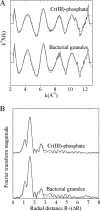Immobilization of Cr(VI) and its reduction to Cr(III) phosphate by granular biofilms comprising a mixture of microbes
- PMID: 20173073
- PMCID: PMC2849200
- DOI: 10.1128/AEM.02792-09
Immobilization of Cr(VI) and its reduction to Cr(III) phosphate by granular biofilms comprising a mixture of microbes
Abstract
We assessed the potential of mixed microbial consortia, in the form of granular biofilms, to reduce chromate and remove it from synthetic minimal medium. In batch experiments, acetate-fed granular biofilms incubated aerobically reduced 0.2 mM Cr(VI) from a minimal medium at 0.15 mM day(-1) g(-1), with reduction of 0.17 mM day(-1) g(-1) under anaerobic conditions. There was negligible removal of Cr(VI) (i) without granular biofilms, (ii) with lyophilized granular biofilms, and (iii) with granules in the absence of an electron donor. Analyses by X-ray absorption near edge spectroscopy (XANES) of the granular biofilms revealed the conversion of soluble Cr(VI) to Cr(III). Extended X-ray absorption fine-structure (EXAFS) analysis of the Cr-laden granular biofilms demonstrated similarity to Cr(III) phosphate, indicating that Cr(III) was immobilized with phosphate on the biomass subsequent to microbial reduction. The sustained reduction of Cr(VI) by granular biofilms was confirmed in fed-batch experiments. Our study demonstrates the promise of granular-biofilm-based systems in treating Cr(VI)-containing effluents and wastewater.
Figures







Similar articles
-
Sustainable bioreduction of toxic levels of chromate in a denitrifying granular sludge reactor.Environ Sci Pollut Res Int. 2018 Jan;25(2):1969-1979. doi: 10.1007/s11356-017-0600-3. Epub 2017 Nov 6. Environ Sci Pollut Res Int. 2018. PMID: 29105040
-
X-ray absorption near edge structure and extended X-ray absorption fine structure analysis of standards and biological samples containing mixed oxidation states of chromium(III) and chromium(VI).Appl Spectrosc. 2007 Mar;61(3):338-45. doi: 10.1366/000370207780220912. Appl Spectrosc. 2007. PMID: 17389076
-
The effects of hydraulic retention time (HRT) on chromium(VI) reduction using autotrophic cultivation of Chlorella vulgaris.Bioprocess Biosyst Eng. 2017 Dec;40(12):1725-1731. doi: 10.1007/s00449-017-1827-6. Epub 2017 Sep 4. Bioprocess Biosyst Eng. 2017. PMID: 28871394
-
Chromium-microorganism interactions in soils: remediation implications.Rev Environ Contam Toxicol. 2003;178:93-164. doi: 10.1007/0-387-21728-2_4. Rev Environ Contam Toxicol. 2003. PMID: 12868782 Review.
-
Mechanistic Insights of Ethylene Polymerization on Phillips Chromium Catalysts.Polymers (Basel). 2024 Mar 2;16(5):681. doi: 10.3390/polym16050681. Polymers (Basel). 2024. PMID: 38475365 Free PMC article. Review.
Cited by
-
Fabrication of Unique Magnetic Bionanocomposite for Highly Efficient Removal of Hexavalent Chromium from Water.Sci Rep. 2016 Aug 9;6:31090. doi: 10.1038/srep31090. Sci Rep. 2016. PMID: 27502074 Free PMC article.
-
Chromate tolerance and removal of bacterial strains isolated from uncontaminated and chromium-polluted environments.World J Microbiol Biotechnol. 2019 Mar 21;35(4):56. doi: 10.1007/s11274-019-2638-5. World J Microbiol Biotechnol. 2019. PMID: 30900044
-
Implantation of Bacillus pseudomycoides Chromate Transporter Increases Chromate Tolerance in Bacillus subtilis.Front Microbiol. 2022 Mar 7;13:842623. doi: 10.3389/fmicb.2022.842623. eCollection 2022. Front Microbiol. 2022. PMID: 35330768 Free PMC article.
-
Reduction of Hexavalent Chromium and Detection of Chromate Reductase (ChrR) in Stenotrophomonas maltophilia.Molecules. 2018 Feb 13;23(2):406. doi: 10.3390/molecules23020406. Molecules. 2018. PMID: 29438314 Free PMC article.
-
Cloning of Nitrate Reductase and Nitrite Reductase Genes and Their Functional Analysis in Regulating Cr(VI) Reduction in Ectomycorrhizal Fungus Pisolithus sp.1.Front Microbiol. 2022 Jul 7;13:926748. doi: 10.3389/fmicb.2022.926748. eCollection 2022. Front Microbiol. 2022. PMID: 35875523 Free PMC article.
References
-
- Ackerley, D. F., C. F. Gonzalez, M. Keyhan, R. Blake II, and A. Matin. 2004. Mechanism of chromate reduction by the Escherichia coli protein, NfsA, and the role of different chromate reductases in minimizing oxidative stress during chromate reduction. Environ. Microbiol. 6:851-860. - PubMed
-
- Al Hasin, A., S. J. Gurman, L. M. Murphy, A. Perry, T. J. Smith, and P. H. E. Gardiner. 2010. Remediation of chromium(VI) by a methane-oxidising bacterium. Environ. Sci. Technol. 44:400-405. - PubMed
-
- APHA. 1995. Standard methods for the examination of water and wastewater, 19th ed. American Public Health Association, Washington, DC.
-
- Beun, J. J., A. Hendriks, M. C. M. van Loosdrecht, E. Morgenroth, P. A. Wilderer, and J. J. Heijnen. 1999. Aerobic granulation in a sequencing batch reactor. Water Res. 33:2283-2290. - PubMed
Publication types
MeSH terms
Substances
LinkOut - more resources
Full Text Sources

